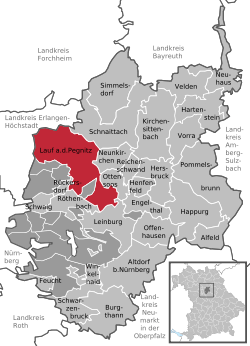Lauf an der Pegnitz
Lauf an der Pegnitz (Northern Bavarian: Lauf an da Pegnitz) is a town to the East of Nuremberg, Germany. It is the capital of the district Nürnberger Land, in Bavaria. It is in the valley of the River Pegnitz, which flows through the town.
Lauf a.d.Pegnitz | |
|---|---|
 Old town hall and the market square | |
 Coat of arms | |
Location of Lauf a.d.Pegnitz within Nürnberger Land district  | |
 Lauf a.d.Pegnitz  Lauf a.d.Pegnitz | |
| Coordinates: 49°30′37″N 11°16′38″E | |
| Country | Germany |
| State | Bavaria |
| Admin. region | Mittelfranken |
| District | Nürnberger Land |
| Subdivisions | 29 Stadtteile |
| Government | |
| • Mayor | Benedikt Bisping (GRÜNE) |
| Area | |
| • Total | 59.80 km2 (23.09 sq mi) |
| Elevation | 327 m (1,073 ft) |
| Population (2018-12-31)[1] | |
| • Total | 26,515 |
| • Density | 440/km2 (1,100/sq mi) |
| Time zone | CET/CEST (UTC+1/+2) |
| Postal codes | 91207 |
| Dialling codes | 09123 (09126) |
| Vehicle registration | LAU, ESB, HEB, N, PEG |
| Website | www.lauf.de |
In 2009, the municipality developed a climate protection plan which was supported by the German Ministry for the Environment.[2]
Sons and daughters of the town
- Hermann Roesler (1834-1894), economist
- Martin Lauer (1937-2019), athlete and Olympic medalist 1960 (4 × 100-meter relay), born in Cologne, lived in Lauf for decades
- Martin Jellinghaus (born 1944), athlete and Olympic medalist 1968 (4 × 400-meter relay)
- Marlene Mortler (born 1955), politician (CSU), Member of the Bundestag
- Timo Rost (born 1978), football player

Lauf an der Pegnitz, View to the old town and Pegnitz
gollark: Or should they?
gollark: Yet again, SQLite has surprised me with a useful feature nobody seems to know about, `spellfix1`.
gollark: https://www.wikihow.com/Enrich-Uranium
gollark: I sort of vaguely assumed you were German. Because of your mildly German-sounding name.
gollark: Fascinating.
References
- "Fortschreibung des Bevölkerungsstandes". Bayerisches Landesamt für Statistik und Datenverarbeitung (in German). July 2019.
- http://www.lauf.de/index.php?goto=aktuelldetails&sid=7540&PHPSESSID=dd85b1d993daa2a6109d9cff95891dd1.
This article is issued from Wikipedia. The text is licensed under Creative Commons - Attribution - Sharealike. Additional terms may apply for the media files.